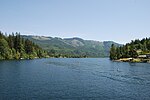Lake Whatcom

Lake Whatcom (from the Lummi word for "loud water") is located in Whatcom County, Washington, United States. It is the drinking water source for approximately 85,000 residents in the city of Bellingham as well as Whatcom County. It is approximately 10 miles (16 km) in length and 1 mile (1.6 km) in width at its widest. Lake Whatcom is located and managed within three political jurisdictions: the city of Bellingham, Whatcom County, and the Lake Whatcom Water and Sewer District. The lake is a popular area for motor boating, swimming, fishing, and other recreational activities. The lake is divided into three basins. Basin 1, the Silver Beach Basin, is the furthest north, and has a maximum depth of 100 feet (30 m). Land use in Basin 1 is primarily residential development, with one large park and several small parks. Basin 2, the Geneva Basin, is the central basin where the drinking water for the city of Bellingham is withdrawn. This basin is the shallowest, with a maximum depth of just 40 to 60 feet (12 to 18 m). Land use is primarily residential, with a mix of lake protection program properties and some rural forestry. Basin 3 is the southernmost basin and is the most remote. At its greatest depth, Basin 3 is 328 feet (100 m) deep, and is estimated to contain 96% of the lake's total water volume. Land use in Basin 3 is composed of scattered residential development, mostly in the community of Sudden Valley, as well as rural and commercial forestry. The total area of the Lake Whatcom Watershed is 142 square kilometers (55 sq mi). There are nine annual streams and approximately 25 additional small creeks and tributaries that flow into Lake Whatcom, accounting for 23 sub-watersheds in all. Lake Whatcom drains into Bellingham Bay by way of Whatcom Creek. The lake has only one island, the 3-acre (12,000 m2) Reveille Island, owned by Camp Firwood, which is believed to be the site of past ceremonies by Native Americans, due to the presence of pictographs and a zoomorphic stone bowl found on the island.
Excerpt from the Wikipedia article Lake Whatcom (License: CC BY-SA 3.0, Authors, Images).Lake Whatcom
Geographical coordinates (GPS) Address Nearby Places Show on map
Geographical coordinates (GPS)
| Latitude | Longitude |
|---|---|
| N 48.733055555556 ° | E -122.32805555556 ° |
Address
Sunnyside
98228
Washington, United States
Open on Google Maps






